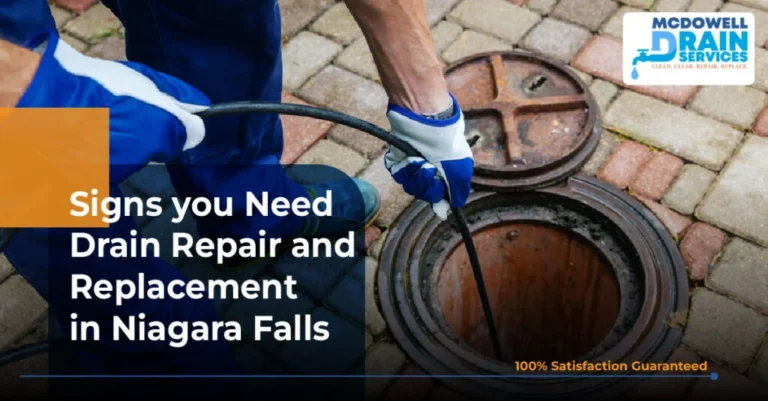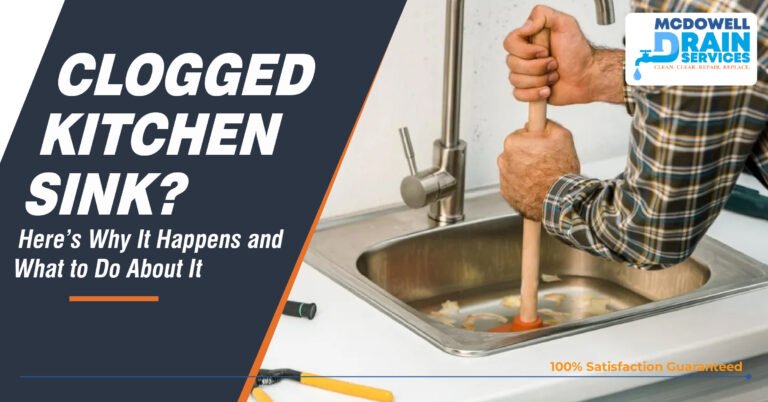Basement flooding in St. Catharines can strike any homeowner—from Port Dalhousie’s lakeside bungalows to Western Hill’s hillside homes—after heavy rain, rapid snowmelt, or system failures. Acting quickly and wisely can save you thousands in repairs, mold remediation, and lost belongings.
At McDowell Drain & Waterproofing, we’ve protected St. Catharines basements for over 45 years. This guide—now expanded to over 1,000 words—blends critical safety steps, smart DIY tactics, and professional solutions, with strategic internal links to services that will keep your home dry year-round.
1. Prioritize Personal Safety
Floodwaters pose serious hazards:
Power Shut-Off
Before entering, locate and turn off the breaker for your basement circuits. Water and electricity don’t mix.
Protective Gear
Wear rubber boots, gloves, and eye protection to guard against contaminants and sharp debris.
Stay Out if Unsafe
If water exceeds a few inches or you detect wiring, call our emergency drain services in St. Catharines immediately.
2. Diagnose the Flooding Source
Understanding why your basement flooded lets you target the fix:
Clogged Storm Drains or Overland Runoff
Heavy downpours can overwhelm city drains. Clear gutters and consider professional drain repair in St. Catharines to restore flow.
Failed Sump Pump
A malfunctioning pump or lack of battery backup leads to recurring floods. Upgrade with a sump pump installation in St. Catharines for reliable, 24/7 protection.
Sewer Backflow
During intense storms, municipal lines can back up. A backwater valve installation in St. Catharines prevents raw sewage from entering your home.
Foundation Cracks & Poor Grading
Hydrostatic pressure pushes water through even hairline cracks—permanent solutions include foundation crack repair in St. Catharines and exterior grading adjustments.
Clogged Weeping Tile
Perimeter drains under your slab can become blocked. A weeping tile replacement in St. Catharines or interior waterproofing install intercepts groundwater before it seeps in.
3. Rapid Basement Water Removal
Time is critical—every hour of standing water increases structural and mold damage:
Small Puddles
A household wet/dry vacuum works for shallow areas.
Deep Flooding
Contact McDowell’s industrial basement water removal team. Our high-capacity pumps clear water up to 10× faster, preserving your concrete slab and stored belongings.
Prompt removal reduces drywall swelling, wood rot, and mold risk, especially in St. Catharines’ humid summers.
4. Thorough Drying, Cleaning & Disinfection
Once water is out, stop mold before it starts:
Air Circulation & Dehumidification
Place high-powered fans and a commercial dehumidifier in opposite corners.
Remove Porous Materials
Discard soaked carpet, insulation, and drywall—they harbor moisture and mold spores.
Sanitize Hard Surfaces
Scrub walls and floors with EPA-approved disinfectants.
Our mold prevention services include industrial-grade sprays and HEPA vacuuming for stubborn infestations.
5. Document Every Detail
Insurance claims succeed with clear evidence:
Photograph & Video
Capture overall flood levels, damaged contents, and any visible cracks or leaks.
Time-Stamp & Note Causes
Record exactly when flooding began and suspected sources—
“overland water” vs. “sewer backup” coverage depends on cause.
Retain Receipts
Save invoices for pump-out, cleanup, and repairs to substantiate your claim.
6. Professional Assessment & Permanent Repairs
A licensed technician from McDowell will perform a full inspection:
Foundation Crack Repair
Using polyurethane injections to seal active leaks permanently.
Sump Pump & Backup Testing
We ensure your primary pump and battery backup function under load.
Backwater Valve Inspection
Verifies the valve closes properly to block sewer backflow.
Interior & Exterior Waterproofing
Seal walls and improve grading to divert water—ask about our exterior waterproofing in St. Catharines.
Sewer Camera Inspection
CCTV scopes reveal hidden blockages in your weeping tile and storm drains.
These measures transform a reactive cleanup into a long-term defense against future flooding.
7. Why St. Catharines Homes Are Vulnerable
Local conditions make proactive measures essential:
Mixed Clay & Sandy Soils
Poor drainage and shifting ground exert constant hydrostatic pressure.
Aging Infrastructure
Many sewers and catch basins date to mid-20th century designs.
Variable Topography
Runoff from the Niagara Escarpment and nearby creeks funnels water toward low-lying basements.
Climate Trends
Environment Canada reports a 14% increase in heavy-rain days over five years.
Understanding these factors helps homeowners choose the right combination of sump pump, waterproofing, and backwater valves for lasting protection.
8. Flood Prevention Tips for St. Catharines
• Install a Dual-Pump Sump System
With battery backup + high-water alarm.
• Fit a Backwater Valve
Prevents municipal sewage surges.
• Annual Drain Maintenance
Hydro-jet perimeter & interior drains.
• Maintain Gutters/Downspouts
Discharge water at least two metres away.
• Seal Foundation Cracks
Use professional-grade sealants or injections.
• Schedule a Yearly CCTV Inspection
Check weeping tile & storm lines for blockages.
Combining these creates a multi-layer flood defense tailored to St. Catharines’ geography.
9. Case Study: Western Hill Residence
“After six inches of basement water from a summer storm, McDowell’s team arrived in under two hours. They pumped out water, installed a new sump pump with battery backup, and replaced damaged weeping tile—all in one day. We’ve had no issues in three subsequent storms!”
— Raj P., Western Hill, St. Catharines
This example illustrates how rapid response plus targeted repairs can end the cycle of repeated flooding.
10. DIY vs. Professional Cleanup
| Task | DIY Approach | McDowell Professional |
|---|---|---|
| Water Removal | Shop vac | High-capacity pump trucks |
| Mold Remediation | Household bleach | Industrial anti-mold treatments |
| Structural Inspection | Visual check only | Thermal imaging & crack sealing |
| Drainage Upgrades | Gutter cleaning | Weeping tile & sump installs |
DIY helps immediately, but professional service ensures long-term, code-compliant solutions.
Frequently Asked Questions
Q: Does my insurance cover basement flooding in St. Catharines?
A: Only with “overland water” or “sewer backup” endorsements.
Q: How much does a sump pump installation cost?
A: Usually $2,000–$3,500 depending on model and backup options.
Q: Can I install a backwater valve myself?
A: No—St. Catharines bylaws require licensed installers.
Q: Is interior waterproofing enough?
A: Best protection = interior + exterior waterproofing.
Q: How often should I test my sump pump?
A: Every 3–4 months, especially before spring melt & fall storms.
12. Take Action Now
Don’t wait for the next storm.
If your St. Catharines basement has already flooded—or you’re worried about future risk—contact:
📞 McDowell Drain & Waterproofing – (905) 431-5612
Or book a free, no-obligation estimate online.
From urgent flood response to permanent waterproofing and drainage upgrades, we’re your trusted St. Catharines experts—available 24/7.





